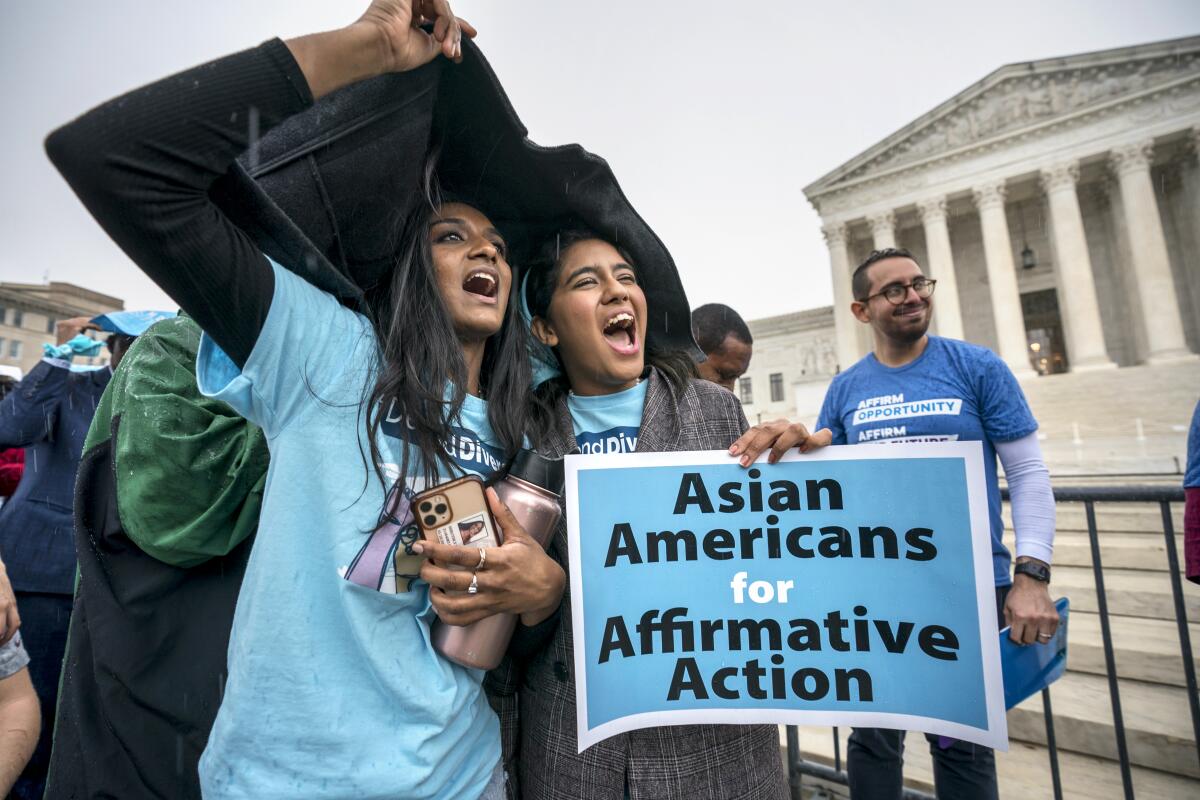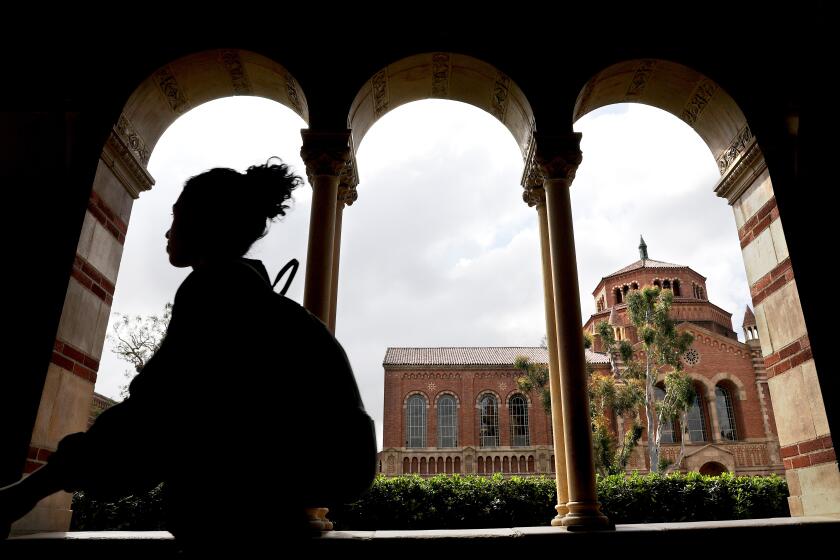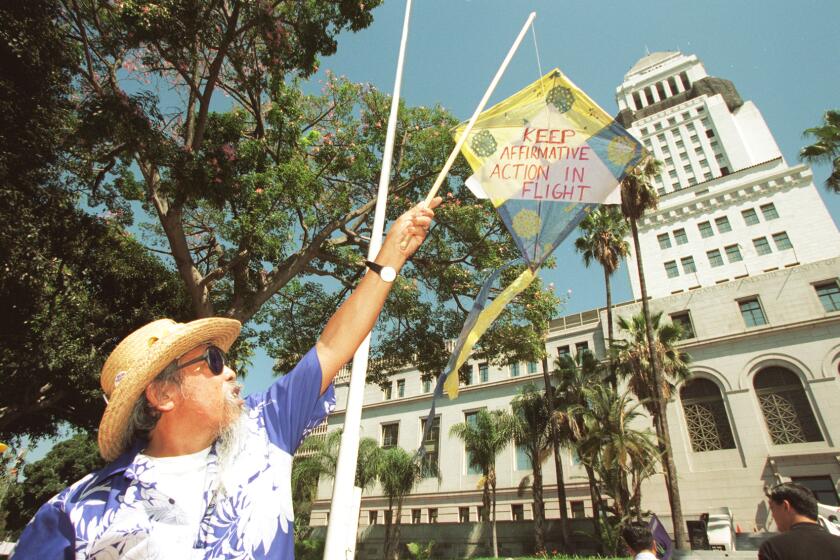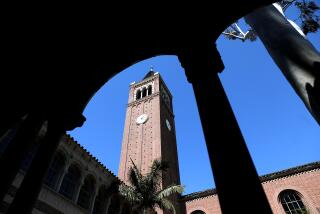Editorial: Supreme Court’s affirmative action ban is a catastrophic blow to the American dream

- Share via
The Supreme Court‘s decision Thursday blocking higher educational institutions from using affirmative action policies when considering student applications will have catastrophic effects at a time when the nation is still grappling with generations of racism.
The Supreme Court ruled that using race as a factor in college admissions is unconstitutional in a decision that affects two cases, one filed against Harvard College and another against the University of North Carolina. It was an unsurprising position for the majority-conservative court, but devastating nonetheless.
The decision overturns decades of legal precedent that boosted efforts by higher education institutions to diversify their student bodies. Private universities that receive federal funds are also affected.
Debate leading up to the Supreme Court’s decision has stirred up plenty of misconceptions. We break down the myths and explain the reality.
Previous Supreme Court rulings had preserved the right of colleges and universities to consider race and ethnicity as part of a comprehensive, individualized assessment in deciding whom to admit. Those decisions rightly recognized that colleges and universities benefit from a diverse student body having more vibrant classroom discussions and learning skills that will help them thrive in a multiracial society.
As well, these policies also helped corporate America have more diverse workplaces. Though quotas are illegal, federal affirmative action policies generally call for government agencies and many government contractors to make sure their workforce demographics reflect their community. The ruling will not affect private companies, though antidiscrimination policies have generally encouraged these corporations to have a diverse workforce.
Writing for the majority, Chief Justice John G. Roberts Jr. said that the admissions programs “lack sufficiently focused and measurable objectives warranting the use of race, unavoidably employ race in a negative manner, involve racial stereotyping, and lack meaningful endpoints.”
Notably, the decision leaves open the possibility of students mentioning in their college application essays how their racial background may have had an impact on their life. The decision says that “nothing in this opinion should be construed as prohibiting universities from considering an applicant’s discussion of how race affected his or her life, be it through discrimination, inspiration, or otherwise.”
The idea that Asian Americans need higher SAT scores than others to get into Harvard is a fallacy based on a misreading of a study that didn’t look at other admissions factors.
In a dissenting opinion, Justice Sonia Sotomayor blasted the decision: “The Court subverts the constitutional guarantee of equal protection by further entrenching racial inequality in education, the very foundation of our democratic government and pluralistic society.”
The death knell for affirmative action has been sounding for years. Critics claim affirmative action policies benefit Black and Latino students, as well as others from underrepresented communities, at the expense of white and Asian students. Both lawsuits included in the Supreme Court ruling were filed by Students for Fair Admission, whose litigation is largely funded by an organization that also supports white supremacist groups, according to reports in Salon and Media Matters for America. Not surprisingly, the leader of the group also filed a lawsuit that gutted the Voting Rights Act.
California’s two public university systems have been banned from using race as a factor in admissions since voters passed Proposition 209 in 1996. (A ballot measure to repeal it in 2020 failed.) Instead, public universities have tried to expand the racial and economic diversity of the student body through other means. For example, the UC system no longer requires applicants’ test scores or letters of recommendation, which tend to benefit wealthier and white students. In addition, six of its campuses participate in the Transfer Admission Program, which guarantees admission for community college students who fulfill certain requirements. Community colleges tend to enroll higher rates of Latino and Black students.
The Supreme Court ruling will probably reduce the numbers of Latino and Black students and other underrepresented groups at selective colleges, unless those higher education institutions figure out other ways to ensure diverse student bodies.
Colleges and universities must radically transform their admissions processes. Notably, they must do away with preferential treatment for students who can use legacy, athletic ability and donations or connections by family as a leg up. At Harvard, applicants benefiting from these preferences made up about 43% of admitted white students between 2009-14, in contrast to less than 16% of non-white students, according to a study. Without this preferential treatment, about three-fourths of the white applicants would have been rejected.
Opponents of affirmative action argue that simply eliminating it will automatically create a level playing field for all students. It won’t.
Banning affirmative action in college admissions hardly makes America race-blind. Its institutions are still steeped in racial and economic inequities, reflected in disproportionately high infant mortality rates in Black communities, higher pollution levels in working-class communities and discriminatory school policies, such as harsher discipline meted out to Black and Latino students.
Ironically, this is the most diverse Supreme Court in history and two justices have acknowledged that they benefited from affirmative action in education. But they have opposite stances on the policy, reflecting its divisive nature. Justice Clarence Thomas has said, “God only knows where I would be today” without affirmative action, though he has been a staunch opponent of the policy for decades. In a concurring opinion in Thursday’s decision, Thomas wrote that he has yet “to understand exactly how racial diversity yields educational benefits.”
Sotomayor called affirmative action a “door-opener” that changed her life.
The kind of inequities that Thomas and Sotomayor endured continue to exist for many, particularly as the gap between the rich and poor has widened. Now, the Supreme Court has made it more difficult for the nation to address these inequities.
More to Read
A cure for the common opinion
Get thought-provoking perspectives with our weekly newsletter.
You may occasionally receive promotional content from the Los Angeles Times.













